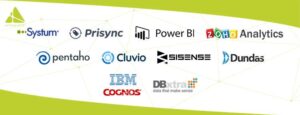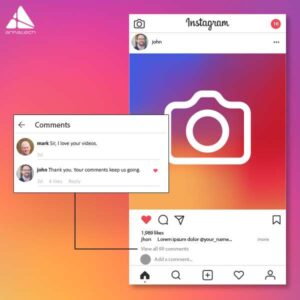Latest Blogs
Software Development
Afnan Ali
Apr 03, 2025
Guide on How to Build a CMS in a Short Time in 2025
Read More...

Top 10 Business Intelligence Tools You Need for Your St...
Business Intelligence (BI) tools help you in deriving insights from your internal data that helps businesses in making tactical and strategic decisions. It is often used interchangeably with business analytics or data analytics. BI is the discipline of recognizing company requirements and finding alternatives to various business issues. In simpler words, it is a set of functions and techniques that work as a link between stakeholders. They help them recognize the structure, policies, and operations of the organization. They can also recommend alternatives to assist the business in achieving its objectives.

Various IT companies are providing customized business intelligence solutions. Here is a list of Top 10 Business Intelligence Tools You Need for Your Startup Company:
Dundas is an intuitive drag and drop functionality. It has been there in the market for around 25 years already. Dundas can help you in transforming data into visually appealing and understandable reports that can be substantially customized. With the analysis of these reports, you can draw the right conclusions without the need of an analytical team. It also offers a 45-day free trial. Moreover, it has flexibility in pricing which enables it to fit the needs of different users.
In case if you are a non-technical person, DBxtra can help you in generating the type of insights traditionally reserved for coders. It can help you integrate with all types of databases without having a deep knowledge of SQL. Once you get all the data, you can put them into charts, tables or even in a presentation. With one of its main features, it can generate reports. Apart from this, you can create interactive dashboards, pull data right into Excel, or auto-generate and distribute reports. DBxtra also offers 30 days free trial so that you can try before you make a purchase.
This is another tool for non-techy individuals. Sisense is quite user-friendly through which anyone in your team can manage huge and complex number of datasets. Moreover, they can also visualize and analyze them without the interference of your IT department. Not to forget, it gathers data from a number of sources including Adwords, Google Analytics and Salesforce. It also incorporates in-chip technology which makes data processing quick as compared to others.
Zoho‘s business intelligence is considered as the best solution for larger businesses and data sets as compared to all others mentioned here. It is able to incorporate information from a wide variety of sources and transform it into a visually attractive and easy-to-understand report for marketing, sales, and other departments. Zoho also offers a 15-days free trial after which you can go for a subscription plan which suits your business requirements and is friendly to your pockets.
It is a business intelligence tool that allows organizations to streamline and improve procedures across numerous B2B and B2C channels in order to increase productivity and effectiveness. It involves a multitude of marketing features, built-in CRM, Inventory Management, B2B and much more. Systum also provides a wide spectrum of integration options, including Amazon, eBay, and QuickBooks.
With user-friendly dashboards and strong reports, e-commerce operators have a diverse understanding of the pricing of their competitors and the product assortments they place on the market. Whether it’s SMBs or Fortune 500, they all are dependent on Prisync’s data to get detailed C-level analysis and execute their A-game to upsurge sales growth and ROI. With the 24/7 customer support team to respond to your queries by making sure you get more than what you have paid for. Prisync offers free onboard service to plan a long-term partnership with all of its clients. It sends notifications and thorough Excel sheets from the market on a regular basis, whether daily or instant, to keep you updated and well within the game.
IBM Cognos Intelligence is a cloud-based business intelligence and analytics tool that can help you in visualizing, analyzing and sharing insights about your business. A number of factors hinder the process of analyzing your business data to comprehend performance and recommend improvements including data storage, various platforms and undue reliance on spreadsheets. It offers a set of tools for reporting, analytics, score carding and tracking of incidences and metrics. This software comprises of several components intended to satisfy the divergent data requirements of a business.
IBM Cognos Intelligence can help you explore information from different angles and perspectives and compare it with data in motion and trends for a more extensive view of your business. The facts you need for better results are right at your fingertips.
Microsoft Power offers non-technical business users with tools for information aggregation, analysis, visualization, and sharing. BI’s user interface is relatively intuitive for customers who are accustomed with Excel, and its extensive integration with other Microsoft products makes it a very flexible self-service tool that needs little upfront training.
It includes analysis services, integration services, master data services, reporting services, and several client applications used for making or working with analytical data. Analysis Services and Reporting Services can be installed as stand-alone servers, in scale-out settings, or as shared service apps in a SharePoint farm. A free version of Power BI is designed for SMB owners; a professional version called Power BI Plus is accessible for a monthly subscription fee.
It is yet another commonly used tool with both open source and a paid version. Pentaho offers helpful basics including data visualization tools like geo-mapping or heat graphs. Also, it provides reporting in a variety of output forms such as PDFs, Excel, and HTML. Apart from that, CT tools are included which gives you the capacity to create custom dashboards on top of Pentaho. As a result, you get impressive amount of control over the program, letting you create more advanced dashboards or incorporate extra visual aids for reports. On the other hand, the software is free, and if your needs are basic or you just want to try something out, the Pentaho community version may be for you.
Cluvio lets you run SQL queries against your database, process data in R, visualize and create interactive dashboards in no time. This platform is set up for the needs of startups and data-driven teams. With easy to understand dashboards, you can add customized time-base and filters, get charts, write SQL and share your dashboards with your team and even with your customers. Additionally, it provides automatic recommendations and alerts to facilitate your work. Cluvio also enables powerful embedding that allows you to readily add analytical features to any website or web application. It has a free subscription to begin with and comparative cheap subscription packages.
Saima Naz
Aug 30, 2019

How to Build Instagram B2B Marketing Campaign for Busin...
Instagram is used by over 25 million companies across the world are taking advantage of Instagram for Business. There are thousands of brands and a number of high-profile B2B organizations that use Instagram to raise brand awareness, engage their audiences and eventually attract new customers. Instagram can help in increasing leads clicking on landing pages, reduce the cost of lead generation, and allow your company to target a niche market. With 800+ million monthly users, Instagram is ruling the social media.
Instagram is a social networking app designed to share pictures and videos from a mobile phone. Everyone who creates an Instagram account has a profile and a news feed. When you post a photo or video, it will become visible on your profile, and those who follow you will see the post in their own feed. which implies you’re also going to see the messages from the people you decide to follow.
Every social media platform offers different strategies. Thankfully, there are a bunch of great B2B Instagram strategies. Here are some of the best ones.

Postings aren’t enough. You need to get involved with your audiences in conversations. Not just post pictures and videos, give an appropriate reply to your community when they leave a response. Take the time to check out other Instagram profiles, pages, have a browsing experience, like some content, and you may also leave friendly comments here and there. Try to engage with the audience so they try to engage with you on your social medium.

Rather than creating an image that showcases your brand’s finest work. Upload colorful and catchy images of your products with a caption that gives all the amazing details about it. The nature of the picture will differ depending on your business genre. For instance, if you are in the fashion domain, if you’re in the fashion space, you can post photos of models/individual wearing your products.

It is a great way to brag about your brand in disguise. Post pictures and comments of your bona fide customers and put their words in caption depicting how satisfied they are with your product or services. You may also upload a video where they can tell how beneficial your product or service has been for them or how your business has helped them in transforming their lives. There’s no better medium like Instagram that excitingly shows the perks of working in a particular company. It is essential to remember that “customers” can mean “employees.” This approach is sometimes referred to as “employee advocacy,” but whatever name you use for it, just remember that your employees have meaningful content to share —and can highlight your company culture in the process.

If you let your audience participate, you don’t necessarily ask them for anything, i.e. visuals and a story. Rather, you usually convey a shared core value through a hashtag. Hashtags make your Instagram content discoverable. Followers get to engage in hashtags, plain and simple. That’s why so many companies are promoting their own branded hashtags to encourage interaction with their customers. PayPal users are using the #PayPalIt hashtag on Instagram, and this has been applied to over 8,000 posts. While Paypal sets the narrative, consumers push the narrative along with their participation in Instagram with the brand.

In the world of Instagram, businesses that tell the most interesting stories are setting up the largest audience. If you want to attract individuals to your company and get them to participate with you, you need coherent visual storytelling that cuts through all of Instagram’s noise. Don’t restrict your focus to your overall picture and video feeds. The Instagram Stories function allows you to develop a slideshow or a picture or video montage. When you’re tied together, tell a tale and give your audience a more personal experience.

Giving useful tips to the customers will make you the apple of the eye. Moreover, it will convince them to think that you are an expert in your industry. You probably might have already given some kind of advice in your content marketing. But this time do it prominently with an Instagram post. Use images with short, pithy pointers. Then, elaborate on those pointers in the caption. Post tips with corresponding comments and responses that make it clear that you understand what you have posted.

Perform a little analysis of your post. See which posts get the most engagement and likes. Do a day-to-day, post-by-post analysis and you will get to know which one is resonating the most. You may also make use of some tool that provides you the whole analytics in one place.
When you get to see everything in one place in different time frames you analyze what is working for you and what is not. Once you are done analyzing, put your focus on the type of content that works best for your business.
Instagram is a potential marketing tool for B2B businesses. But to make the most of it one needs to develop an effective content strategy centered around thoughtful visuals. That being said, with every social platform, it is important to be prepared with the knowledge and tools needed to create ROI through social media.
Saima Naz
Aug 29, 2019

20 Best Web Development Blog You Should Be Reading in 2...
The world of web development is constantly evolving. All thanks to open-source and innovation, as soon as you learn one technology, a new one comes along. Because of its constantly evolving nature, it becomes quite challenging to stay up-to-date in the industry. Thankfully, web development blogs make it easy for anyone to stay up-to-date with the trending topics of today. We’ve gathered some of the finest web design and development blogs for you. Whether it’s learning a fresh UX design application or finding someone to demonstrate the current trends, the internet is full of data on these and many other topics. Let’s take a look at the best 20 web development blogs 2019.
SitePoint is a web-based online community of professionals. It is a learning center for programmers, product creators, developers, designers, entrepreneurs managed by top web professionals.
You can learn about web design & development with SitePoint tutorials, courses, and books — HTML5, CSS3, JavaScript, PHP, Mobile App Development, Responsive Web Design.
It is a web development blog that addresses everything about programming, development, web, as well as life. You can explore a huge variety of online courses, webinars, and tutorials. Also, you can take part in community coding challenges. It incorporates all kinds of the web- material for internet geeks.
CSS- Trick provides tips, tricks, and techniques of using Cascading Style Sheets. It covers articles on JavaScript, jQuery, Sass, WordPress and a lot more. Besides having education blogs, they also provide videos, code snippets, a job board which are the requirements of web persons. Chris Coyier and a team of swell people create, write and maintain CSS-Tricks*.
Since 2006, Smashing Magazine has been there and their blog’s depth and breadth reflects it. You can discover high-quality content on more than 30 topics revolving around web design and development. For instance, HTML & CSS, UX &UI, Typography, Web Design and RWD, and more. Explore a collection of PDF, ePUB and Amazon Kindle in printed and eBooks. This is a phenomenal resource for developers who want to go deeper.
You’ll discover a lot of helpful tutorials and code snippets on Codrops if you’re a front-end developer or web designer. In addition, Codrops also addresses more general web design topics and how a web designer’s role has developed over the years. It has the latest web trends and approaches, tutorials, articles, plugins as well as a handy CSS reference with all the important properties.
It was initiated as a design blog and soon it joined all the top development blogs. You will also discover articles on accessibility, graphics, and layouts in addition to inspirational web design graphics. The Blog also addresses a wide range of topics, including UX design, CSS, and freelancing. For anyone working in the field of web design, it is simply a go-to. If you’re a web designer in quest of an excellent blog design, this is the best spot for you.
It is among the oldest website development blogs. It was initiated as a mailing list back in 1997 but a year later, it shifted towards the blog and ever since it is there. Even though it looks vintage, the architecture of information is 100% contemporary. The site has a minimalist UI despite all the years of content and is extremely easy to navigate. You can find content, design and user experience articles, as well as free-to-use code samples.
This platform has gone through many breakthroughs in the web design and web development business. It provides a huge range of topics. Also, you get to learn about design, user experience, accessibility, design, freelancing, etc. Because it has grown rapidly to become one of the most famous design blogs on the web, you can discover almost anything all kinds of excellent, in-depth articles and tutorials.
It is one of the online magazines which cover 18 web design and web development topics. Topics of articles include information architecture, design inspiration, freelancing, photography, and icons. They have hired a number of writers which benefits you with a number of the different point of views. SpeckyBoy also features tools for web design for those who really need resources.
Code Condo provides straightforward development blog features tutorials and tips on a variety of web design topics. The writers of Code Condo research and provide all the trending topics you have been looking for. If you can’t locate the information you need, you can click a link to web development courses on their freebies page.
This is the right platform if you are looking for ‘How to’ tutorials. It offers 1220+ courses as well as more than 170 eBooks on coding, design and illustration, motion/graphic, game development, photos & videos, etc.
Creative Bloq is a platform for articles on HTML & CSS, branding, fonts, animation, 3D modeling, JavaScript, RWD, UX and more. It is said to be a daily mix of advice and inspiration.
With JavaScript and JavaScript frameworks like React.js and jQuery, David Walsh Blog features in-depth articles as well as brief and crisp coding tips. His blog teaches concepts to aspiring web developers through demos and examples.
Web Design Ledger article is written by web designers for web designers. The goal of Web Design Ledger is to share expertise and resources linked to web design. Topics on this platform range from design templates and themes, to interviews with designers and developers. The blog also covers articles on content management systems (WordPress & Drupal) and development topics like PHP, jQuery, Javascript, NodeJS, etc.
Tutorialzine publishes web design and development tutorials on a regular basis along with compilations of the latest as well as famous JavaScript frameworks and CSS libraries.
Coding Horror is the source of information of the experienced web application developer Jeff Atwood. The blog addresses all kinds of software development and security issues, but it is Jeff’s interest in the human development element that makes the blog stand out.
Onextrapixel is a platform to share useful tips, news, and resources, on design, development, tutorials, tools and other inspirational topics.
Apart from providing a long list of blogs on web design, it is also an online shop for web design resources, tools, and UI Kits and icon packs.
CSS Author is the blog you should be following if you want to generate an interesting and catchy website. This platform provides free templates, design inspirations, resources on coding languages as well as free WordPress themes.
Hongkiat is there to offer you the most inspirational content and all content stuff related to design and technology. You can find tutorials, tips, tricks, techniques, tool recommendations and plenty of freebies. It is the best match for web developers, web designers, bloggers, entrepreneurs, and graphic designers.
Saima Naz
Aug 27, 2019

SEO for Start-ups How to Improve Organic Search Ranking...
Search Engine Optimization (SEO) is something no start-up company can afford to ignore in 2019. But with Google’s algorithm’s ever-increasing complexity, and a million different professionals giving their view on what you need to do to rank higher, how can you determine what you really need to do? SEO is the answer.
Let us start with knowing what SEO means?
SEO stands for optimizing the search engine. And the term improving your SEO strategy includes activities performed to ensure that your website can be found on the results page of a search engine (SERP) when looking for content-related words or sentences on your website.
On-page optimization is more than just putting keywords on the page. You need to create adequately organized quality content using natural features for the targeted keywords. Use every sensible opportunity to add your targeted keywords to your website properly. Otherwise, you will end up missing out on important ranking signals
One must optimize titles, meta descriptions and most importantly body content. Keep two points in consideration in your content:
Remember that, when writing the copy of your website it’s important that not every other word is a keyword or keyword phrase. Google algorithms are searching for material appropriate to the keyword, not just the keyword presence itself. One way they do this is by judging the density of keywords. A decent minimum density is 1%, but generally, it is wise not to exceed 3%.
You now have an account of un-competitive, natural-sounding keywords and the objective of placing in your written copy 1-4 of them per 100 phrases. It is essential to choose where to place them in that copy. Overall, you want a keyword in your article’s title or blog post, at least one in the article’s subtitle or bulleted list, and the rest are naturally spread across the article. Doing so will demonstrate the algorithms of the search engine that your material is extremely relevant to the keyword because it is not only the topic of your copy, but it is all referenced.
Google’s taking mobile optimization seriously has been well-documented for a long period of time. It is an increasingly important ranking factor with mobile-first indexing and mobile performance, and if you don’t already take it seriously, then its time you did. Just look at the figures to know why: recent stats put mobile web traffic as high as 52.4 percent globally. That means that if your website isn’t mobile-optimized (or simply less efficient than your desktop site) or you couldn’t just create a big impression on visitors, you are likely to lose out on leads and revenues.
The reality is that the majority of employees working on your website will do so via a desktop screen. This may lead them to focus solely on optimizing the desktop version of the pages You should encourage your team to frequently view and work through a smaller screen on your website to overcome this issue. This can really assist concentrate the mind on mobile’s significance, and can even lead staff members to uncover problems or methods to enhance efficiency.
This is what Google recommends for companies with both mobile and desktop applications:
Google My Business listing is one of the simplest ways for small companies to boost their digital visibility. Through it all, business owners can regulate how their company is displayed on the search engine results pages of Google.
Google My Business listings, on the other side, also assist search engines to discover precise business data. You can provide details such as contact data, place and company address on your Google My Business Page. You can also add suitable pictures to offer a glimpse of your products or office to your prospective clients. It also brings you an opportunity to write responses to your company ‘ commonly asked questions. To optimize your website for “near me” queries or voice-based searches, Google My Business listings are particularly helpful. Overriding your competitors in local search results is an important step.
Many applications and services from third parties depend on Google to obtain business information. It will also be transmitted to these parties when you update your data on your Google My Business Page. Overall, it can effectively depict your data across various platforms. Small business owners can also gain insights into the behavior of their customers through these listings. You can find out how customers find you using Google Insights. It also demonstrates platforms where there is low visibility. You can customize your marketing campaigns based on this.
From the outside, your small company website may look fine with excellent graphics, colors, and fonts. But if there are technical issues inside, your rankings and traffic are likely to suffer. Spend time fixing the foundation before embarking on a content or link campaign. You can also outsource the complete search engine optimization project to agencies for better results.
You need a good website structure so your websites can be crawled and indexed properly by search engines. When we talk about SEO, some of the most common problems are Speed firstly, replicated content, un-optimized pages, and broken links.
Using social media to get your keywords out there is a wonderful way to keep content fresh. Daily post can do wonders. A brief, daily tweet or a Facebook post about your business is going to do great.
Another great way to keep content fresh is to use social media to get your keywords out there. A short, daily tweet or a Facebook post related to your company will work wonders. Search engine algorithms are going to draw millions of social media users who might just come across your business account at any moment and see that you’re just providing exactly what they’re looking for. To get Google’s attention, use the keyword in your article as a link to your blog would see that your site is connected to and from other Internet edges.
Using photos is one of the finest ways to maintain a client’s attention and break up the text walls that threaten so many websites. The images must, of course, be important to the topic, and the picture URL and caption are a good location to fit in another keyword. Because if a client looks for a keyword instead of an image, you will have an extra opportunity to attract them.
Saima Naz
Aug 25, 2019

Successful YouTube Campaigns that Will Help Your Startu...
Video marketing has become a dependable medium for getting people’s attention and getting your business message across for quite a while now. And as 2019 continues to unfold, more and more data is signaling its continued development and importance. About two-thirds of business owners are planning to create at least three marketing videos this year. Not surprisingly, almost all (87 percent) of those who have earlier invested in video marketing is happy with their ROI.
In order to appeal to the new generation of customers, brands must actively look for creative notions to attract them or hire an expert digital marketing agency. In the face of mounting competition, how do you create your own identity in the ocean of competitors? It seems that the solution lies in video marketing. Let’s figure out how.
Videos have become a tool that carries a variety of marketing and business goals i.e. customer retention, customer support, customer experience, sales, etc. Although for some brands it is very challenging to find the ROI of their videos however that’s also changing. Across the board, businesses use video to serve four main objectives:
We are going to discuss such successful video campaigns of real companies seeing results.
Google Android has introduced a new advertising campaign about unlikely animal relationships. Dogs and dolphins swimming, elephants and sheep playing, and even a duck and a kitten snuggling are among the cute displays. Since cute animals have always been a trend online, this makes it a great advertisement alone. But Good has more to offer.
At the end of these simple, cute pairings, Google brings to mind us that we need to be together, but we don’t need to be the same. This advertising campaign offers us a glimpse of how strong emotional marketing techniques can be if you add happiness to the mix! Besides happiness, there is a great deal of strength behind the human association and the promotion of unity in a globe that seems so divided.
https://www.youtube.com/watch?v=XjJQBjWYDTs&feature=youtu.be
‘Like a Girl’ is an award-winning campaign which won Emmy, Cannes Grand Prix award, and the Grand Clio award. Always embarked on a mission to address the social issues that women face during puberty and took it up to appeal to younger audiences. This line implied that women were weaker, ditzy and unable to be powerfully independent. The primary aim of the video was for people to communicate and engage. Building on the concept of the word ‘Like A Girl’ as an offensive word, Always took on the challenge of changing people’s perceptions. The video comprises of engaging youth and sharing their opinions on what ‘ Like A Girl ‘ meant to them. By embracing a familiar sentence that we use every day, it has always been linked to the masses and has triggered a wave of social change.
People in the United States want and seek the truth as though it is being torn apart, polarized and deceived as never before. In such a time, the New York Times advertising campaign truly validating people’s fears of the truth of the world and is still trying to calm them down. This advertisement reveals media of today as challenging it is to find honesty in their media. In a world where media is all bribe and sold for money, the New York Times used their advertisements to prove their commitment to transparency and honesty. This is a strong message for people who are tired of lies, negativity and want the truth. The Truth is Hard is offering a beautiful human link, which sincerely speaks to a globe that wishes clarity.
Amazon introduces its first-ever Echo Spot Device while pulling your and your family’s heartstrings showing how this technology can help connect families. In this ad, an old lonely grandma is shown. Her life was transformed by the insertion of the smart device into her home. Her gift is packed with the instructions “Just ask: ‘Alexa, Call Home.’” The home assistant does just that and the grandma is greeted by her full family on the screen. This message does not only promote their product but also helps us in self-reflecting our selves and our relationship with our grandparents and we might give them a call if it’s been a long time. Amazon not only inspires audiences but this demonstrates their willingness to target elderly individuals and help improve their lives, which also inspires us to be more faithful to the “good-doing” business.
Facebook has been through a bad phase with the violation of personal data leaks and privacy protection. A lot of time unfortunate things happen and companies apologize for that. So, Facebook thought of apologizing through an advertising campaign to send a strong message. They conveyed this message in the advertisement “committed to doing more to keep you safe and protect your privacy so that we can all get back to what made Facebook good in the first place: friends. Because when this place does what it was built for, we all get a little closer.” The audience does get offended if a brand makes mistakes but they get furious if they don’t see any apologies or encounter any improvement. It is the responsibility of a business to relieve the stress and worries of customers about using a product or service.
Trust is essential, and with this video, Facebook shares its dedication and vision to how and what they want their platform to be. Safe, connected and human.
This video directs the audience through moms supporting their children with their dreams and circumstances — whether it’s color prejudice, religion, disability or sexual orientation. Procter & Gamble’s “Thank You Mom” has had a wonderful time being shuffled in the previous few Olympic publicity campaigns. This video encourages the sentiments and achievements of the Olympic athletes and the sacrifices of their support teams, including their mothers.
This video encourages the sentiments and achievements of the Olympic athletes and the sacrifices of their support teams, including their mothers. Like a fair number of people who have had to sacrifice and pass through a lot of dreams, this tale resonates not only with the accomplished individual but also with the emotions of the support system. Moms, relatives, friends, and family can all be connected with the feeling of being supported and being the supporter. This ad campaign is a success since human love and sacrifice are two feelings that individuals can always relate to.
https://www.youtube.com/watch?v=XpaOjMXyJGk&feature=youtu.be
This ad revolves around an artist who loves drawing portraits of women without seeing and completely through verbal descriptions by the women themselves or by someone else. With growing expectations of unachievable beauty criteria, Dove took a perceptive stance to tell women to be gentler to themselves. By contrasting how others perceive them as opposed to how people perceived themselves, they efficiently communicated the message. This famous campaign was run in 25 different languages and showcased in over 110 countries.
The point to make here is Dove smartly tap on the striking trends and utilize a primary message that has the consumers at the heart of it.
Saima Naz
Aug 24, 2019

Android 10 is the Official Name for Android Q
Tech giant Google disclosed Thursday that it will be dumping the sweet names of its mobile operating system, formerly called Android Q, and will simply be replaced by Android 10.
Sameer Samat, vice president of product management for Android, wrote in a blog post. “As a global operating system, it’s important that these names are clear and relatable for everyone in the world. So, this next release of Android will simply use the version number and be called Android 10.” “We think this change helps make release names simpler and more intuitive for our global community.”
As part of this novel idea, Google is also updating its Android logo, opting for a “more modern, accessible look.”
It’s not yet clear when the new software will be available, but the new logo will be pushed out in the “coming weeks with the final release of Android 10.”
The company has had a tradition of naming its phones after something sweet, such as Pie, Oreo, Nougat, and Marshmallow.
In March, the tech behemoth issued the first and showed more features at its yearly I/O developer conference in May.
One of the company’s important selling points for Android 10 is a new tactic to keeping personal information isolated. The new confidentiality features come in the form of more coarse location controls and a devoted privacy section in the settings app.
Android 10 will also support foldable screens, quicker app unveilings and full-on gesture navigation.
A host of organizations have been working with Google through the beta process to ready their devices for the new update. As well as Google’s line of Pixel phones, OnePlus (6 through 7 Pro), LG (G8) and Huawei (Mate 20 Pro) are among the many organizations with devices already certified for the 10 beta program.
Saima Naz
Aug 23, 2019